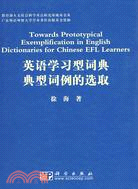相關商品
商品簡介
目次
商品簡介
本書主要探討以下問題:①哪些因素影響英語學習型詞典詞例的選取?②這些因素如何影響典型詞例的選取和呈現?③詞典編纂者應當采取哪些策略確保選例的典型性? 在詞例作為語篇的研究框架中,可確定至少有五個因素影響選例,即用例的意圖、詞例的語言信息量、詞例的源語篇、詞例所適配的詞典語篇以及特定詞典用戶對詞例的需求。因此,典型詞例的選取須滿足意圖性、信息性、銜接性和可接受性等要求。 典型詞例總是蘊含編纂意圖。選例能否傳達明確的意圖,很大程度上取決于詞典編纂者是否正確預測用戶在何種情況下可能查詢目標詞,是否意識到解碼意圖的詞例與編碼目的的詞例起著不同的作用。 就詞例的信息性而言,詞典編纂者須考慮語料庫檢索工具在詞例選取中的運用以及相關的語言學理論對詞例選取的啟示。一些實用的檢索工具,如WordSmith,World Sketch Engine和FrameNet等,可直接用于提取信息量大的詞例。而信息豐富的詞例通常顯示目標詞的語義、搭配和(或)句法信息。框架語義學闡明了詞匯單位的典型框架以及框架成分,對于如何選取語義信息凸現的典型詞例起著指導作用。相關的短語搭配研究則有助于選取搭配信息充分的詞例。配價理論和句法轉換理論中的一些規則對于詞例的選擇起著句法制約作用。 詞例與源語篇之間的銜接問題主要是指示語的處理問題。據調查,人稱指示語通常在詞例中保留。具有口語語篇標記的方位指示語here和there很少出現在詞例中。詞例的時態(即時間指示語)通常限于一般現在時和一般過去時;其他類型的時態除非受動詞語義的影響很少出現在詞例中。 有關詞例與詞典語篇的銜接,編纂者須考慮詞典語篇中的其他因素,包括詞頻、詞性、詞義以及詞的標記性,對詞例選取的影響。英語學習型詞典一般例釋無標記的高頻詞的用法。但為了滿足一些用戶的特殊查詢需求,具有語體或感情色彩標記的詞有時也配例。一個無標記的詞通常每一義項配有兩個以上的例子,而一個有標記的詞通常每兩個義項配有_例。至于詞性的配例,動詞、介詞和形容詞應首先考慮。 詞例的接受性問題可用關聯理論解釋。一個最佳的例子是特定詞典用戶花最小的努力獲得最大的語言信息。這就要求詞典編纂者利用問卷調查的方法以及基于學習者語料庫和平行語料庫檢索,考查特定用戶的顯性和隱性的詞例查詢需求。同時,詞典編纂者應適當采用一些方式,如短語例與句例相結合、黑體、括注、警示例以及對詞例中的不常用詞、復雜結構、文化信息的控制等,有效呈現詞例。 本書最后提出了一個英語學習型詞典典型詞例的選取與呈現的模式。
目次
序
Acknowledgements
Abstract
摘要
Abbreviations
Chapter One Introduction
1.1 Rationale for the Present Research
1.2 Overview of Exemplification Research
1.3 Research Objectives
1.4 Research Methodology
1.5 Research Framework
1.6 Outline of the Book
Chapter Two Intentionality of Illustrative Examples
2.1 Evidence for the Functions of Illustrative Examples
2.1.1 Psycholmguistic Evidence
2.1.2 Empirical Evidence
2.2 Nature of Illustrative Examples
2.2.1 Infinite Utterances vs. Prototypical Examples
2.2.2 Syntagmatic Relationship vs. Paradigmatic Relationship
2.3 Classification of Examples Functions
2.3.1 Descriptive Approach
2.3.2 User-oriented Approach
2.3.3 A Refined Classification of Examples Functions
2.3.4 A Case Study of the Exemplification of the Word monopoly
2.3.5 Discussion
2.4 Evincing lexicographic Intentions in Illustrative Examples
2.5 Summary
Chapter Three Informativity of Illustrative Examples
3.1 Impacts of Technological Innovations on the Choice of Dictionary Examples
3.1.1 Manual Collection of Data
3.1.2 Computer Corpus and KWIC Concordancing
3.1.3 Word Sketch Engine
3.1.4 FrameNet Concordancing
3.1.5 Summary of the Technological Advances
3.2 Semantic Information in Illustrative Examples
3.2.1 Overview of Frame Semantics
3.2.2 Implications of Frame Semantics for Lexicography
3.2.3 Application of Frame Semantics to Exemplification: A Case Study of the Lemma conclude
3.2.4 Procedures for Selecting Informative Examples from Corpus
3.3 Combinatory Information in Illustrative Examples
3.3.1 Significance of Word Combinatory Information in Linguistics and in Lexicography
3.3.2 Classification of Word Combinations: An Overview
3.3.3 Approaches to Phraseological Study
3.3.4 Method
3.3.5 Results
3.3.6 Discussion
3.3.7 Principles of Exemplifying Collocations
3.4 Syntactic Information in Illustrative Examples
3.4.1 Overview of Lexicogrammars
3.4.2 Treatment of Syntactic Information in Illustrative Examples in the Big Five
3.5 Summary
Chapter Four Cohesion Between the Illustrative Example and the Source Text
4.1 Introduction
4.2 Relevant Studies
4:2.1 Theoretical Underpinnings
4.2.2 Critique of Relevant Research
4.3 Method
4.4 Results
4.4.1 Number of Example Sentences in the Sample Data
4.4.2 Person Deictic Expressions in Example Sentences
4.4.3 Place Deictic Expressions in Example Sentences
4.4.4 Time Deictic Expressions in Example Sentences 2
4.5 Discussion
4.5.1 Person Deictics from a Perspective of Information Structure Theory
4.5.2 here and there: Markers of Simultaneous Spoken Discourse
4.5.3 Conditions for Using Minor Types of Verb Tenses
4.6 Summary
Chapter Five Cohesion Between the Illustrative Example and the Dictionary Text
5.1 Relevant Studies
5.2 Method
5.3 Results
5.3.1 Effects of Word Frequency, Part-of-Speech and Lexical Meaning on Exemplification
5.3.2 Factors Affecting Exemplification of Regionalisms
5.3.3 Effects of a Words Subject Field on Exemplification
5.3.4 Effects of a Words Currency on Exemplification
5.3.5 Effects of a Words Style on Exemplification
5.3.6 Effects of a Words Attitude on Exemplification
5.3.7 Summary of the Results
5.4 Discussion
5.5 Summary
Chapter Six Acceptability of Illustrative Examples to EFL Learners
6.1 Relevant Studies
6.1.1 Users Needs for Examples
6.1.2 Effectiveness of Different Types of Examples in Language Learning Tasks
6.1.3 Effects of the Users Proficiency Level and the Background Knowledge on the Selection of Examples
6.1.4 Summary of Previous Studies
6.2 Method
6.3 Results
6.3.1 Results of the Questionnaire Survey
6.3.2 Results of the CLEC Concordances of the Erroneous Structure although...but..
6.4 Discussion: Theorizing the Findings with Relevance Theory
6.4.1 Overview of Relevance Theory
6.4.2 Interpreting with Relevance Theory the Criterion of Acceptability for Illustrative Examples
6.5 Summary
Chapter Seven Conclusions
7.1 Main Findings
7.2 Implications
7.2.1 Implications for the Practice of Dictionary Exemplification
7.2.2 Implications for the Development of Metalexicographical Theory
7.3 Limitations of the
7.4 Concluding Remarks
References
Appendix
Appendix 1
Appendix 2
Appendix 3
Appendix 4
Appendix 5
Acknowledgements
Abstract
摘要
Abbreviations
Chapter One Introduction
1.1 Rationale for the Present Research
1.2 Overview of Exemplification Research
1.3 Research Objectives
1.4 Research Methodology
1.5 Research Framework
1.6 Outline of the Book
Chapter Two Intentionality of Illustrative Examples
2.1 Evidence for the Functions of Illustrative Examples
2.1.1 Psycholmguistic Evidence
2.1.2 Empirical Evidence
2.2 Nature of Illustrative Examples
2.2.1 Infinite Utterances vs. Prototypical Examples
2.2.2 Syntagmatic Relationship vs. Paradigmatic Relationship
2.3 Classification of Examples Functions
2.3.1 Descriptive Approach
2.3.2 User-oriented Approach
2.3.3 A Refined Classification of Examples Functions
2.3.4 A Case Study of the Exemplification of the Word monopoly
2.3.5 Discussion
2.4 Evincing lexicographic Intentions in Illustrative Examples
2.5 Summary
Chapter Three Informativity of Illustrative Examples
3.1 Impacts of Technological Innovations on the Choice of Dictionary Examples
3.1.1 Manual Collection of Data
3.1.2 Computer Corpus and KWIC Concordancing
3.1.3 Word Sketch Engine
3.1.4 FrameNet Concordancing
3.1.5 Summary of the Technological Advances
3.2 Semantic Information in Illustrative Examples
3.2.1 Overview of Frame Semantics
3.2.2 Implications of Frame Semantics for Lexicography
3.2.3 Application of Frame Semantics to Exemplification: A Case Study of the Lemma conclude
3.2.4 Procedures for Selecting Informative Examples from Corpus
3.3 Combinatory Information in Illustrative Examples
3.3.1 Significance of Word Combinatory Information in Linguistics and in Lexicography
3.3.2 Classification of Word Combinations: An Overview
3.3.3 Approaches to Phraseological Study
3.3.4 Method
3.3.5 Results
3.3.6 Discussion
3.3.7 Principles of Exemplifying Collocations
3.4 Syntactic Information in Illustrative Examples
3.4.1 Overview of Lexicogrammars
3.4.2 Treatment of Syntactic Information in Illustrative Examples in the Big Five
3.5 Summary
Chapter Four Cohesion Between the Illustrative Example and the Source Text
4.1 Introduction
4.2 Relevant Studies
4:2.1 Theoretical Underpinnings
4.2.2 Critique of Relevant Research
4.3 Method
4.4 Results
4.4.1 Number of Example Sentences in the Sample Data
4.4.2 Person Deictic Expressions in Example Sentences
4.4.3 Place Deictic Expressions in Example Sentences
4.4.4 Time Deictic Expressions in Example Sentences 2
4.5 Discussion
4.5.1 Person Deictics from a Perspective of Information Structure Theory
4.5.2 here and there: Markers of Simultaneous Spoken Discourse
4.5.3 Conditions for Using Minor Types of Verb Tenses
4.6 Summary
Chapter Five Cohesion Between the Illustrative Example and the Dictionary Text
5.1 Relevant Studies
5.2 Method
5.3 Results
5.3.1 Effects of Word Frequency, Part-of-Speech and Lexical Meaning on Exemplification
5.3.2 Factors Affecting Exemplification of Regionalisms
5.3.3 Effects of a Words Subject Field on Exemplification
5.3.4 Effects of a Words Currency on Exemplification
5.3.5 Effects of a Words Style on Exemplification
5.3.6 Effects of a Words Attitude on Exemplification
5.3.7 Summary of the Results
5.4 Discussion
5.5 Summary
Chapter Six Acceptability of Illustrative Examples to EFL Learners
6.1 Relevant Studies
6.1.1 Users Needs for Examples
6.1.2 Effectiveness of Different Types of Examples in Language Learning Tasks
6.1.3 Effects of the Users Proficiency Level and the Background Knowledge on the Selection of Examples
6.1.4 Summary of Previous Studies
6.2 Method
6.3 Results
6.3.1 Results of the Questionnaire Survey
6.3.2 Results of the CLEC Concordances of the Erroneous Structure although...but..
6.4 Discussion: Theorizing the Findings with Relevance Theory
6.4.1 Overview of Relevance Theory
6.4.2 Interpreting with Relevance Theory the Criterion of Acceptability for Illustrative Examples
6.5 Summary
Chapter Seven Conclusions
7.1 Main Findings
7.2 Implications
7.2.1 Implications for the Practice of Dictionary Exemplification
7.2.2 Implications for the Development of Metalexicographical Theory
7.3 Limitations of the
7.4 Concluding Remarks
References
Appendix
Appendix 1
Appendix 2
Appendix 3
Appendix 4
Appendix 5
主題書展
更多
主題書展
更多書展本週66折
您曾經瀏覽過的商品
購物須知
大陸出版品因裝訂品質及貨運條件與台灣出版品落差甚大,除封面破損、內頁脫落等較嚴重的狀態,其餘商品將正常出貨。
特別提醒:部分書籍附贈之內容(如音頻mp3或影片dvd等)已無實體光碟提供,需以QR CODE 連結至當地網站註冊“並通過驗證程序”,方可下載使用。
無現貨庫存之簡體書,將向海外調貨:
海外有庫存之書籍,等候約45個工作天;
海外無庫存之書籍,平均作業時間約60個工作天,然不保證確定可調到貨,尚請見諒。
為了保護您的權益,「三民網路書店」提供會員七日商品鑑賞期(收到商品為起始日)。
若要辦理退貨,請在商品鑑賞期內寄回,且商品必須是全新狀態與完整包裝(商品、附件、發票、隨貨贈品等)否則恕不接受退貨。




















![漂鳥集[中英雙語版]](https://cdnec.sanmin.com.tw/product_images/957/957146403.jpg)



